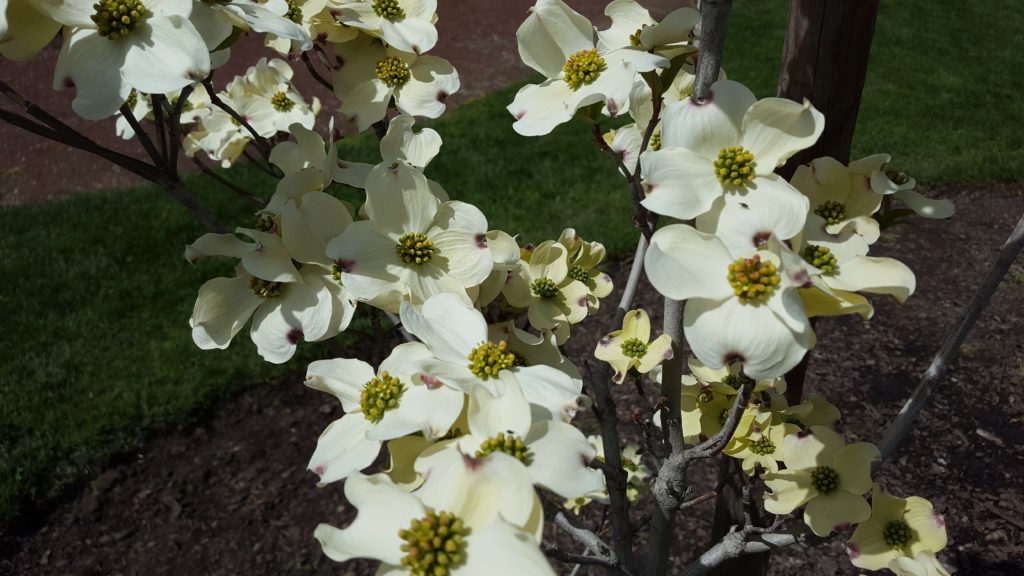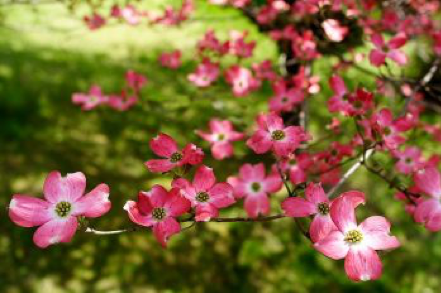- About Us
- Our Work
- Tree Info
- Get Involved
- Blog
- Volunteer
- Support Us
By Canopy Team on April 22, 2019

Photo by Elise Willis
Tree Spotlight Series: Follow along as we learn about the fascinating trees that live among us. This series is in partnership with Rhee Lab in the Plant Biology Department of the Carnegie Institution for Science.
Other posts in the series: ginkgo biloba, Douglas fir, giant sequoia, Chinese tallow, silver-dollar gum, Monterey pine, green dracaena, coast live oak, cork oak, Japanese maple, silver birch, dawn redwood, Japanese persimmon ‘Hachiya’, carob, California bay, avocado, and southern magnolia.
Every year, the National Cherry Blossom Festival is held along the Potomac River in Washington D.C. to commemorate the gift of cherry blossom trees from Japan in 1912. In response, America had sent back flowering dogwood saplings. However, the following decades saw only one flowering dogwood survive in Japan.
In 2012, America donated 3,000 more saplings to commemorate the 100-year anniversary, most of which were planted in Tokyo and the Tohoku region, site of the 2011 earthquake and tsunami. The impact of the flowering dogwoods reaches beyond diplomacy to many uses, marking it more than just a gorgeous plant.
The flowering dogwood (Cornus florida) is a U.S. native, but requires much attention to cultivate here. They need moist, acidic soil, and afternoon shade but good morning sun away from intense heat. The species also has low salinity tolerance and sensitive roots susceptible to disease and pests.
Since growing and caring for the plant from a seed is difficult, commercial growers usually use grafting to propagate the plant. Grafting is a technique that involves joining tissues of different plants so that they grow as one. Grafting can also help repair any damage on established trees.
The close attention that the flowering dogwood requires is paid off with a gorgeous plant. Growing up to about 30 feet high, this small, deciduous tree has flowers surrounded by what appear to be petals but are actually specialized leaves.
The flowers are usually visible in a yellow-green flower-head, where roughly twenty flowers are densely packed, surrounded by four conspicuously large white, red, or pink leaves.
The resulting plants are so gorgeous that breeders have selected many cultivars, of which more than twenty are sold commercially in the United States. Cultivars are plants that have been selected for desirable characteristics, which in the case of flowering dogwoods, revolve around appearance and disease resistance.
For example, the cultivar called “Amerika Touch-O-Pink” has large, pink “petals” with improved disease resistance.

Despite its appearance, the flowering dogwood has many applications that go deeper than its beauty. The most direct application is in the production of scarlet dyes from its bark. Furthermore, the dense wood has been used for many wooden tools like golf club heads, mallet, and butcher’s blocks.
The plant has been used to treat a variety of ailments, including healing most wounds, malaria, breaking fevers, and diarrhea. However, the scientific evidence backing up these historical uses of the tree’s bark is lacking. Regardless, the high calcium and fat content in their fruits also makes them an important component of many animal diets.
With uses ranging from being a simple ornamental tree to embellish American suburbs to feeding wildlife, the flowering dogwood is an amazing species.
See the gorgeous flowering dogwood in person on Canopy’s Community Center Tree Walk, Old Palo Alto Tree Walk, or Palo Verde Tree Walk.

Ankush Bharadwaj was a 2018 summer intern at the Rhee Lab in the Plant Biology Department of the Carnegie Institution for Science. He is currently an undergraduate student majoring in Microbiology, Immunology, and Molecular Genetics at the University of California, Los Angeles. His hobbies include being outdoors, where he usually spends his time kayaking, hiking, or simply skateboarding around.